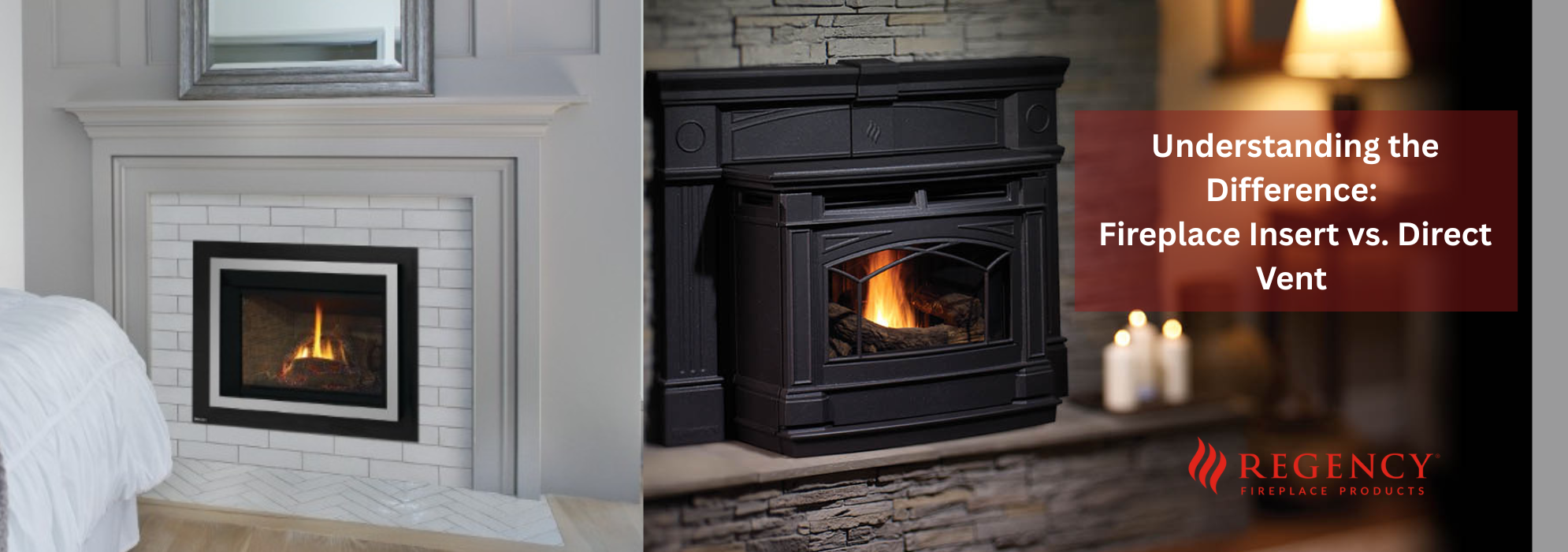
When choosing a new fireplace for your home, one of the first decisions you’ll encounter is whether to go with a fireplace insert or a direct vent fireplace. Both options offer excellent heating performance and modern aesthetics, but they are designed for different applications and project types.
This blog will help you understand the difference between the two, how each works, and which one may be better suited to your space and lifestyle.
What Is a Fireplace Insert?
A fireplace insert is a self-contained heating unit designed to be installed into an existing masonry fireplace. It is an excellent way to upgrade an old, inefficient open fireplace into a modern, high-efficiency heating system.
How It Works:
The insert is fitted into the fireplace cavity and connected to a sealed venting system that runs up through the existing chimney. This setup creates a closed combustion system that improves safety and heating efficiency.
Best Use Cases:
- Homes with an existing wood-burning masonry fireplace.
- Homeowners looking to increase heat output without major renovation.
- Those wanting to retain the charm of a traditional fireplace while improving efficiency.
What Is a Direct Vent Fireplace?
A direct vent fireplace is a complete fireplace unit that doesn’t require an existing fireplace or chimney. Instead, it uses a sealed venting system to draw air in from outside the home for combustion and vent exhaust gases back outside.
How It Works:
These fireplaces can be installed on almost any exterior wall or even vented vertically through a roof. Because they do not use indoor air for combustion, they maintain excellent indoor air quality while offering reliable and efficient heat.
Best Use Cases:
- New home construction
- Home additions or renovations without an existing fireplace
- Projects where flexible placement and modern design are key
Installation Considerations
Fireplace Inserts
Installation of an insert is typically straightforward when a masonry fireplace is already present. The insert slides into the opening, and a stainless steel vent liner is routed through the chimney. A custom faceplate is used to seal the opening and complete the look.
Direct Vent Fireplaces
These units require framed enclosures, whether you're building into a wall or designing a feature installation. Venting can go directly out the wall or up through the ceiling, allowing for placement in nearly any room of the home.
Energy Efficiency & Heat Output
Both options offer sealed combustion systems, which are significantly more efficient than traditional open fireplaces.
Fireplace Inserts
By converting an open fireplace into a closed system, inserts dramatically reduce heat loss. Many models include blowers or fans to help circulate warm air throughout the room, offering effective supplemental heating.
Direct Vent Fireplaces
Designed with high-efficiency ratings, these fireplaces provide powerful zone heating for a wide range of room sizes. They’re especially well-suited for modern, open-concept living spaces.
Style & Design Flexibility
Whether your style leans classic or contemporary, both fireplace inserts and direct vent fireplaces offer a variety of aesthetic options.
Fireplace Inserts
Inserts allow you to retain the look and feel of a traditional fireplace while updating it with modern performance. Choose from various trims, surrounds, and interior panels to suit your décor.
Direct Vent Fireplaces
These units provide greater flexibility for custom fireplace designs. Whether you want a square unit for a cozy corner or a long, linear fireplace as a statement piece, direct vent models come in styles ranging from traditional to ultra-modern.
Making the Right Choice
Ultimately, the choice between a fireplace insert and a direct vent fireplace depends on the layout of your home and the scope of your project. At Regency, the process starts with understanding your current setup—whether it’s a masonry fireplace in need of conversion or a new space being built from the ground up.
We then help you choose the right fuel type (gas, wood, or electric), determine heating needs based on room size and usage, and match you with a design that complements your personal style—traditional, contemporary, or somewhere in between.
Final Thoughts
Choosing between a fireplace insert and a direct vent fireplace isn’t just a matter of taste—it’s about finding the right solution for your home’s structure and your lifestyle. A fireplace insert is ideal for upgrading an existing masonry fireplace, while a direct vent fireplace offers design freedom and efficient heat in new or remodeled spaces.
At Regency Fireplace Products, we’re here to help you find the perfect fit. With decades of fireplace innovation, a commitment to quality, and dealer support across North America, you can count on Regency to warm your home with style, comfort, and performance.